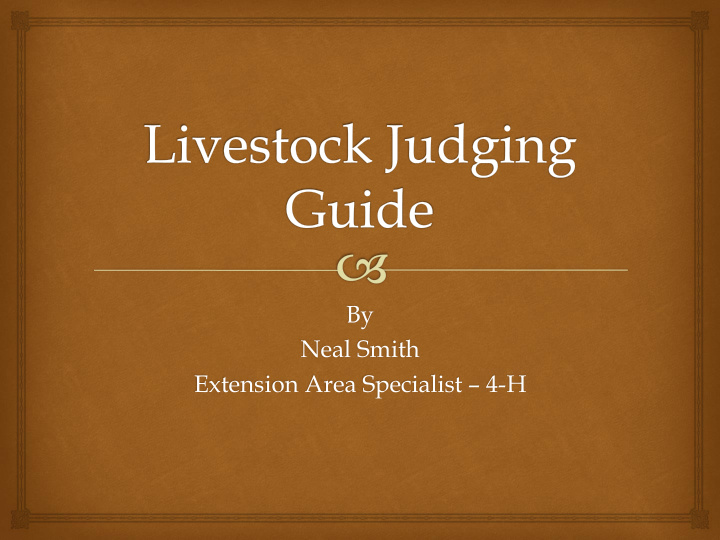



By Neal Smith Extension Area Specialist – 4-H
Module 2: Beef Cattle Judging Breeding Heifers
Judging Beef Cattle Will Evaluate: Breeding Heifers Market Steers Do Not Judge Bulls at Regional 4-H Contest Learn Terms To Use: When judging breeding cattle When judging market animals
Judging Beef Cattle Evaluating Breeding Cattle Ideal breeding heifers or bulls should: Be well balanced Have ample size and scale Show meat-type characteristics Have sound feet and legs Exhibit proper breed and sex character Display adequate reproductive organs
Ideal Beef Heifer Angular through neck & shoulders Long, level rump Feminine head Strong topline Neat tailhead Neat, smooth shoulder Deep, long Bold spring of rib muscled rear quarter Neat throat, dewlap Long bodied Long stifle & brisket Deep rear flank Deep ribbed
Ideal Beef Heifer Long bodied Natural Well balanced thickness down back & loin Long, smooth muscled rear quarter Smooth shoulder Deep, wide chest floor Correct set of hocks Correct set of Legs set wide feet and legs apart
Judging Heifers Begin at the Ground & Work UP Start at the Rear and Work Forward Rank Animals Based On: Traits of importance they possess Evaluate most important traits first Contestants should: Eliminate any easy placings Place the remainder based on the volume of the important traits
Judging Heifers Ranking of Traits in the Order of Importance: Soundness & structural correctness Capacity or volume Style and balance Degree of muscling Femininity
Judging Heifers Soundness and Structural Correctness Feet, legs and connected structure Biggest factors physically affecting longevity Start evaluation: At the ground Work up a joint at a time Carefully consider Feet Pasterns Hocks Rump Knees Shoulders
Judging Heifers Feet should be: Big Even-toed Squarely placed Toes pointing straight forward
Judging Heifers Splay-footed Poor depth of heel Feet turned out and not Feet with poor depth of heel. squarely under heifer. Hoof-skin junction sets too Puts stress on inside toes close to the ground. and inside of the knees.
Judging Heifers Pasterns should be: Strong and flexible Allows cushion and give in foot & ankle Straight pasterns: Restrict flex Weak pasterns: Too much set or angle Adds pressure on joints Correct set to the pasterns
Judging Heifers Pastern has too much set, Pastern is too straight, limiting depth of heel and lacking flex and adding pressure to the ankle. cushion.
Judging Heifers Hocks should be: Constructed of a clean, flat bone With a slight degree of set Allowing for maximum: Power Mobility Correct set to the hocks
Judging Heifers Post-legged Sickle-hocked Cow-hocked Hock is too straight, Too much set to the hock, Hocks turn in, does not severely limits forces rear feet too far provide good balance flexibility and puts under the heifer adding of weight, and places stress on the joint. pressure to hip and stress on inside toes rump. and ankles
Judging Heifers Correct rump structure should be: Level from hooks to pin bone Essential for length of stride Correct rump Rump structure too structure steep
Judging Heifers Shoulder set and shape: Control degree of motion in front end Allows for flexibility Determine correct shoulder angle: View cattle on the move Pay attention to length of stride Rear foot should step in track made by front foot Nice set and smoothness of shoulder
Judging Heifers Poor set or angle of Shoulder too course, shoulder, too straight, does not lay smooth will restrict stride
Judging Heifers Evaluating Capacity or Volume Amount of body volume a heifer possesses Necessary to perform at a high level And, still maintain body condition Associated with: Production traits Performance traits
Judging Heifers Evaluating Capacity or Volume Bold spring Determined by: of rib Body width (spring of rib) Body depth Body length Heifers should be: Wide bodied Good spring of rib Depth should be: Uniform from front to back More than 50% of heifer’s height from top of back to ground
Judging Heifers Lacks adequate capacity Too short bodied Very narrow bodied, with Lacks depth, especially in no spring of rib rear flank
Judging Heifers Evaluating Degree of Muscling Degree of muscling in heifers should be evaluated: First through center of the quarter Base width of rear feet as heifer walks Shape over heifer’s top Critical to compare base width at the ground to top width On a lean animal that is heavy muscled: Base width and top width will be equal
Judging Heifers Evaluating Degree of Muscling Fat can cause mistakes in evaluating muscle shape Fat can: Mask shape Change shape Hide shape Invent shape
Judging Heifers Light muscled Average muscled Heavy muscled Very narrow Average width Good width
Judging Heifers Evaluating Femininity Femininity refers to the “prettiness” of the heifer Traits to consider: Long, clean neck Refinement of head Length of neck Refined Angularity of neck & shoulder head, narrow Blending of shoulder to forerib muzzle Clean, angular shoulder Good blending of shoulder to forerib
Judging Heifers Coarse head Too much shoulder Excess Too thick hide in thru neck dewlap & shoulder
Test Your Skills Place this class of heifers 1 2 3 4
Official Placing 3 rd 1 st 2 nd 4 th 2 1 4 3 Official Placing: 1 – 4 – 2 – 3 Cuts: 5 – 2 - 5
Recommend
More recommend